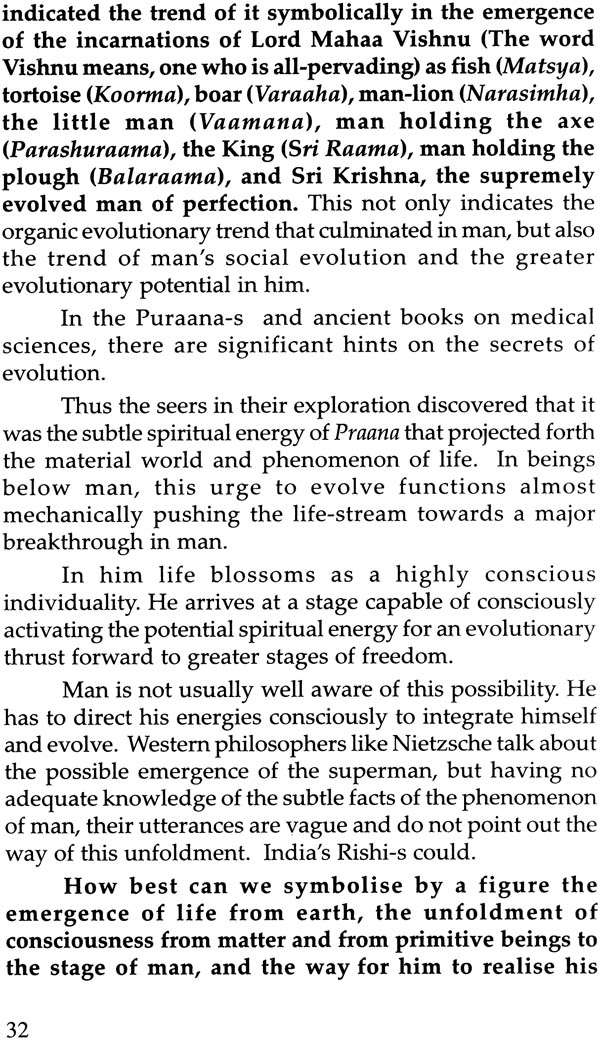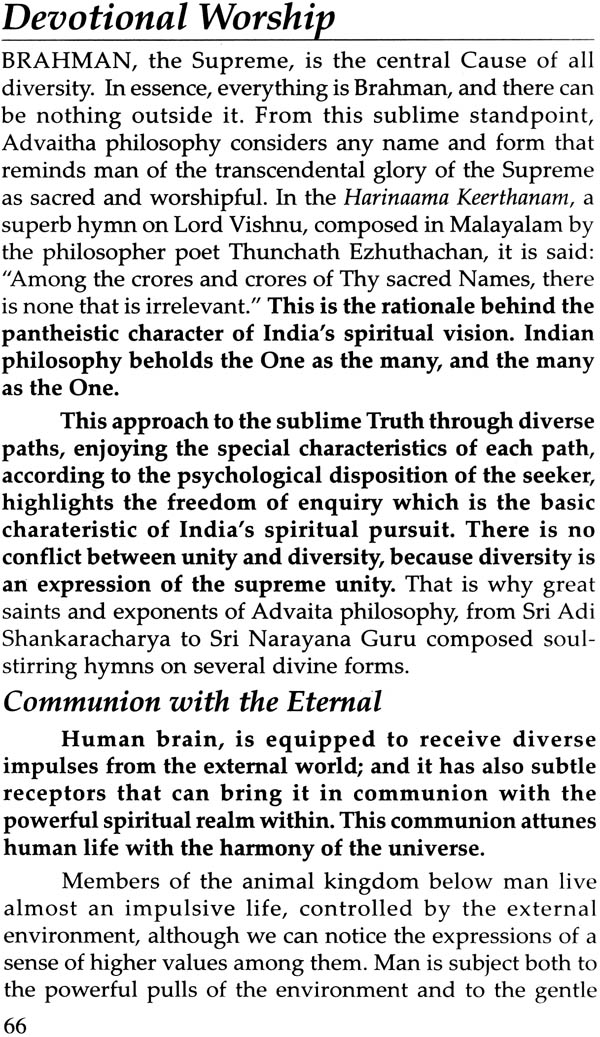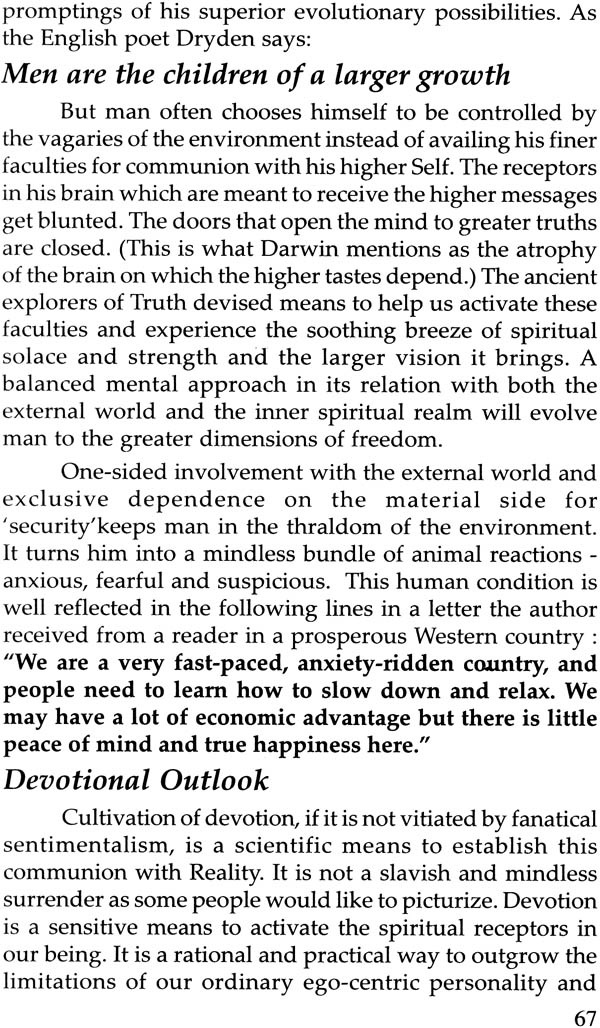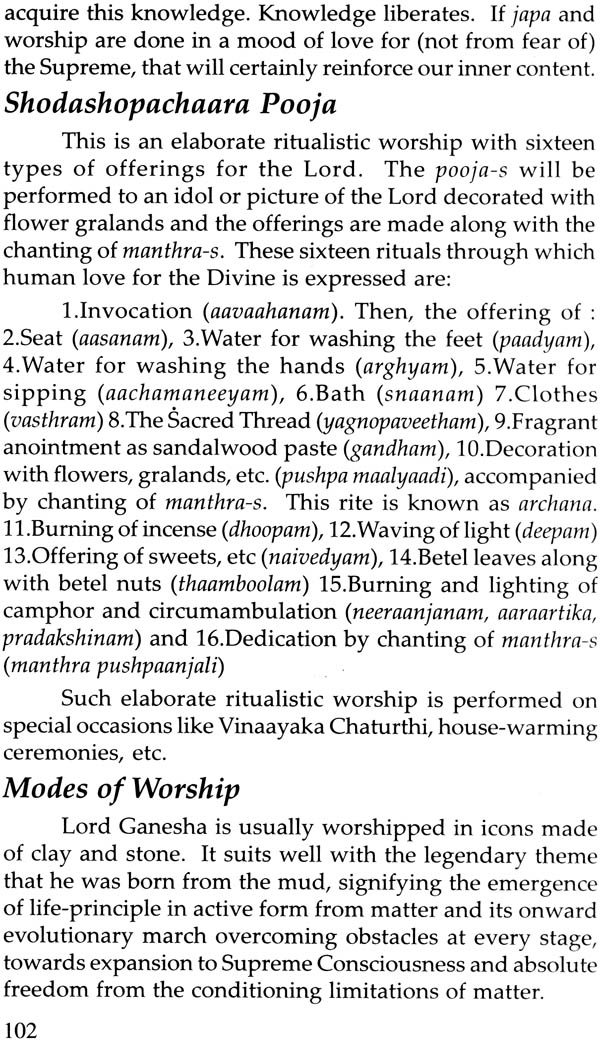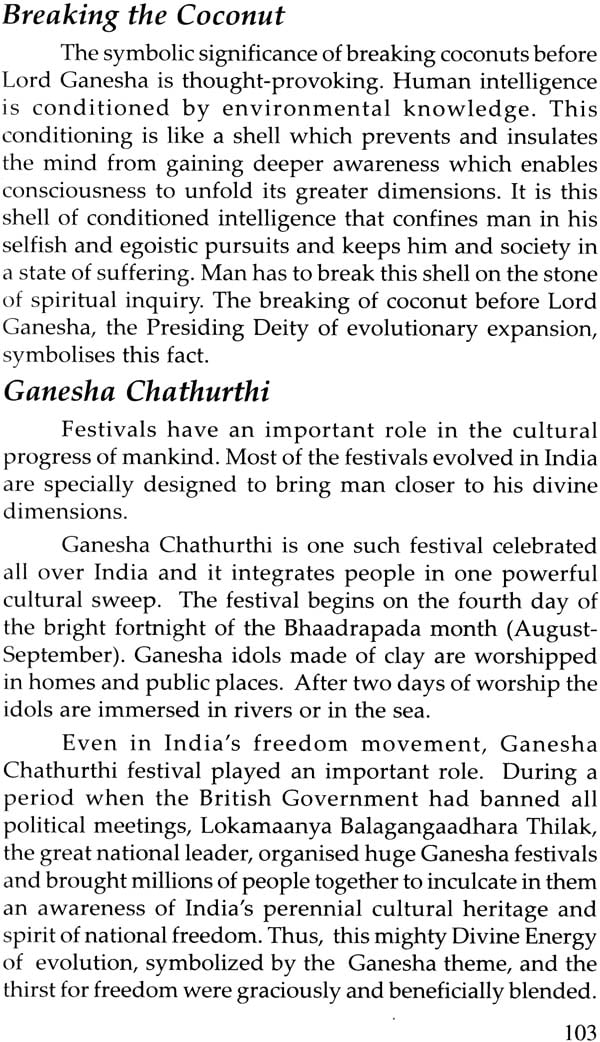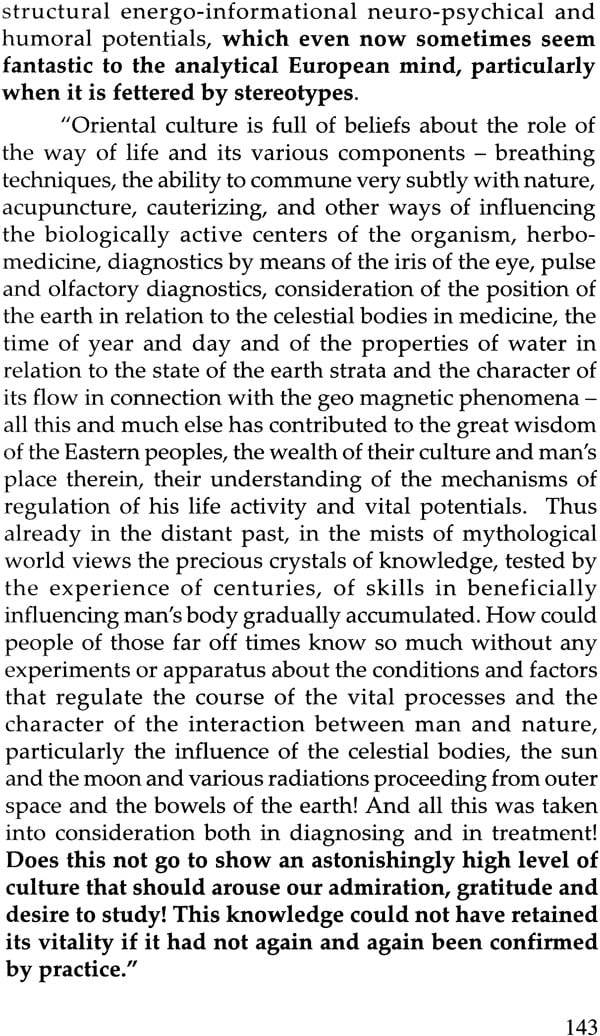
Sri Ganesha (Alphabet of Reality Series: Significance of Divine Forms)
Book Specification
| Item Code: | NAK723 |
| Author: | Srikant |
| Publisher: | Integral Books, Kerala |
| Language: | Sanskrit Text With Transliteration and English Translation |
| Edition: | 2015 |
| ISBN: | 8186107053 |
| Pages: | 144 (41 B/W Illustration) |
| Cover: | Paperback |
| Other Details | 8.5 inch X 5.5 inch |
| Weight | 170 gm |
Book Description
The figure of Sri Ganesha along with His rat mount symbolizes the theme of the unfoldment of consciousness. The Ganesha theme is a sign post that shows mankind the way of directing the evolutionary energy to reinforce and realize the grater potentials.
The strange form of Ganesha represents the Divine Power that prompts consciousness locked in earth to express its greater dimensions through living beings and equips the human being to transcend the obstacles in the material and spiritual dimensions till one evolves to reaize the freedom of the unconditioned Reality.
Faith in a Supreme Power gives relief and solace to man's worldly afflictions. It brings him the strength and reassurance of communion with the Reality behind the transcendental phenomenal world.
Man is in a constant pursuit of happiness. Experience makes him realise that he cannot derive abiding happiness from the evanescent objects of the world. That which gives him much pleasure today often turns out to be a great source of suffering tomorrow. The thoughtful inquirers of India recognised that the real source of happiness is their own consciousness, not their senses, body or the objects of the world. This made them meditate upon the nature of consciousness which led them to the experience of a blissful eternal Reality which is the source of their consciousness and of the phenomenal world.
Human phenomenon has an inborn urge to evolve from the biological to the psycho-social and spiritual dimensions. Every pursuit for happiness is in a way an expression of this urge, although many lose sight of the harmonious natural path, go awry and suffer. Others cultivate the moral and spiritual values of life, the real way of human evolution, experiencing an increasing sense of freedom and happiness. And a few of them even attain the bliss of Supreme Wisdom.
Man exists in a world of forms and qualities, which like the colours latent in the transparent light, have their source in Supreme Reality. By nature the human mind is conditioned by these forms and qualities. To draw strength and wisdom from the Source, mind has to be trained and refined so that it becomes a fit receptacle to contain and express the divine glory. As a practical aid for this communion, the sages conceived suitable forms that symbolise sublime spiritual principles. Worship of such divine forms invokes these principles and the forms function as powerful conduits of divine grace and guidance.
The earliest literary works of mankind, the Veda-s contain invocations to various Gods and Goddesses. In the karma kaanda of the Veda-s, which deals with the practice of rituals etc., there are elaborate descriptions of the modes of worship and the manthra-s to invoke the spiritual powers represented by them. It was in the age of the Upanishad-s, the unique philosophical treatises on sublime spiritual truths, special efforts were made to explain the inner significance of the Vedic concepts. In them the Rishi-s declared that it is the same Reality that people choose to call by different names - ekam sad, vipraa bahudhaa vadanthi. They called the supreme Truth as Brahman. They approved the worship of Reality in different forms, as the worship would help to refine the mind and equip it to be receptive to comprehend the supreme Truth. They, however, warned against any fanatical sticking to the form aspect and advised to use them intelligently as a stepping stone to Reality realising the fact that the Reality symbolised by the form transcends all forms.
While the Upanishad-s contain sublime philosophical discussions on the Absolute, the Puraana-s are replete with symbolic stories of perennial interest to the legend-loving human mind, and in these the great Rishi-s embodied high philosophical and spiritual principles. These legends served to inculcate higher values in society. Several forms of deities were conceived by human insight and imagination; but for an earnest seeker they will gradually reveal their secrets, for which the keys can be found often in the same texts. Likewise, the forms of deities are pregnant with profound meaning. Those who explore their significance will find that their several heads and hands, the various weapons, the ornaments, the garments and even their colours signify lofty spiritual principles. As the Upanishad-s try to make us aware of the highest principles relating to the eternal Source of this wonderful universe, the divine forms of Puraanic origin throb with the vision and power of that wisdom.
I am glad this series of books, Alphabet of Reality, are intended to explore the language of divine forms beginning with the worship of Sri Ganesha, known as Sri Vigneshwara, who wards off all obstacles. The effort I hope will gladden all those who believe in Sanaathana Dharma, the Universal Rhythm leading to human refinement and perfection.
The form of Sri Ganesha differs from other Godly forms. The face of an elephant having one tusk, a human body with a big pot-belly, four hands, the body entwined by a serpent and a rat as the mount of the huge figure! He is worshipped both for material prosperity and spiritual illumination. Sri Ganesha is the Presiding Deity of the divine energy in man, Kundalini, which is capable of elevating human consciousness to its supreme state.
In the hymns on Sri Ganesha, He is extolled as the very symbol of the supreme Truth that transcends all qualities and forms. His form symbolises both the way and the goal of spiritual pursuit. This book will be thought- provoking even to the modem scientist for its rational approach to a great theme. I hope that the seekers of spiritual wisdom will find this a useful compendium. May Lord Ganesha's Grace illumine our path for harmonious life and spiritual fulfilment.
India’s heritage holds profound spiritual truths. Those who have the mind to enquire come by consoling facts about life in her philosophical texts. These facts give man a meaningful vision about himself and his destiny. Knowledge unfolds its greater fields as human quest advances. If the pursuit is honest, free, unbiased and with the humble passion of a mountaineer who yearns to see more expansive vistas at every climbing step, the realms of awareness and beauty expand, enriching the texture of life. The quest refines, strengthens and expands the human personality.
Modern scientific enquiry began solely on a materialistic basis. From its early beginnings in the sixteenth century, as science advances to its stupendous discoveries in the closing phase of the twentieth century, we see its worldview turning more philosophical, with an Einstein or Carl Jung tending to speak like a Yaajnavalkya or Pathanjali of ancient India.
There are people who believe that the forms of Gods and Goddesses are meaningless figments of imagination of primitive ages. It is difficult to judge which age is more primitive in cultural terms - the age of the Rig Vedic Rishis, who could conceive such high human ideals: "Let the world live in harmony and peace"; "Let noble thoughts come to us from every side," or our age of flourishing trade in weapons of mass annihilation! When false signals from computers hold the potential to convert mankind into piles of ash any moment, everyone in our times has to contemplate on what O. Nash has said: "There has been a lot of progress during my lifetime. But I am afraid it's heading in the wrong direction."
In different phases of human history, in this ancient land lived intellectual prodigies, who boldly explored into the mysteries of life and gained the spiritual wisdom, which they passed on to posterity through symbolism - by means of stories, diagrams and forms, enabling the knowledge to survive the long passage of time.
The philosophical trends of modern science, which tend to converge towards the insights of the seers, equip the present-day intellect to probe deeper into ancient wisdom for its rediscovery in modern terms, as would help man to transform the present period of darkness and uncertainty into that of light and reassurance.
The traditional sciences and the philosophical concepts of India are pregnant with profound vistas of knowledge about the human phenomenon and Nature. For example, the direct experiences of thousands keep up the relevance of astrology alive, even in our highly technological age, though it eludes a convincing scientific explanation. This shows the existing gap between ancient insights and modern scientific perspective. It points out that the ancient explorers had wrested out some keys from Nature to open some of the mystery boxes of human life and Nature. The wondrous genetic code that determines the structural details of a living being was an unsuspected biological secret during Darwin's time. Yet, it was there subtly directing the destiny of life. Nature still keeps away many of her profound secrets from the observation of the scientific eye and it seems that the ancient Rishi-s had a breakthrough access to many subtle realities, as they were earnest seekers, not mere technologists using their brains for material gains.
Man's enquiry about himself and about his relation with Nature begins from lower psychological levels. A leap from a lower to a superior level often needs the help of a spring-board. The concept of deities, the facets of Brahman, the supreme Reality, is such an aid for inner exploration. There is no fundamental distinction in the inner significance of various deities despite the external variations in names and forms. They are all extolled in essence as Brahman. Forms merge into the principles they signify and into the wisdom they convey.
Any fanatical concept of a formless one-God partial to a group of people or religion is alien to Indian philosophy, which recognises the infinite diversity as the expression of the One Reality. It inspires to see the divine Essence in diversity. It gives one the freedom of choice to hitch on any desirable form or forms or a formless concept, that symbolise that Essence so as to merge in communion with the Reality and realise the fact that the seeker and the worshipful Deity are essentially the same blissful Brahman, the transcendental Source of all diversity beyond the transitory phenomena.
In the Indian philosophical context God is not just a formless superman, who is partial to those who avow faith in some particular religion. He is Sat-Chit-Ananda - Existence, Consciousness, Bliss. He is unconditioned freedom. If He has no freedom to assume forms, He is not Almighty. The universe of innumerable forms is an expression of God's freedom to take forms. The universe is not a creation of God. It is the omnipresent He Himself. Man is not a condemned slave of God, by praising whom the slave gets manifold material gifts. Through a discipline of inner evolution, man can expand his consciousness and transcend his biological limitations and realise the freedom and glory of God. Everything is God only - eeshaa-vaasya- midam sarvam. There is no anti-God. It is the distorted conditioned ego, not in harmony with the blissful Reality, that turns itself into a demoniac Asura or Satan. When the fallen ego realises its inner Essence, it regains its divinity. Submission of man's conditioned ego to his own blissful and powerful inner dimensions is the means to raise himself to a superior cultural status, to a superior civilization. The forms of deities are meaningful symbols of this scope of human transcendence. They signify the freedom of choice in man's spiritual quest and evolution.
The meaningful forms were manifested in the super- conscious state of seers representing the diverse facets and power aspects of Reality. Mystic diagrams and forms of deities are letters of a unique language of divine symbolism. This series of books, Alphabet of Reality, begins with the form of Sri Ganesha, the God of auspiciousness and remover of obstacles, without propitiating whom no ritual or ceremony is performed in the Hindu way of life.
The Ganesha concept is potent with many shades of sublime meaning. Here we are mainly examining the theme in its aspects as the guiding light in the evolutionary unfoldment of human consciousness.
In this series an attempt is being made to probe into the deeper meaning of divine forms and their spiritual significance. The effort is neither to confine the concepts within an intellectual frame, nor to explain the ancient insights, limiting them in the bounds of the present-day scientific knowledge, but to use the emerging philosophical trends of modem science as pointers to the transcendental dimensions of existence discovered by India's ancient seers. This approach is rather new. It may stimulate thought for further enquiry. With this expectation, the following study is placed before the readers.
| Foreword by Swami Mridananda | 6 |
| Introduction | 9 |
| The Form and Its Significance | 14 |
| Meaningful Legends | 45 |
| Devotional Worship | 66 |
| A Glimpse into History | 92 |
| Temples of Sri Ganesha | 108 |
| Ganesha Worship Abroad | 114 |
| Sri Ganesha Sthothra-s | 119 |
| The Milk Miracle - Reassessment | 130 |
| A Freudian' Misinterpretation and Denigration of a Profound Divine Theme | 137 |
